The HTC One (M8) Review
by Anand Lal Shimpi & Joshua Ho on March 26, 2014 7:00 PM EST- Posted in
- Smartphones
- HTC
- Mobile
- HTC One
Snapdragon 801 Performance
The M8 is the first smartphone we’ve tested to use Qualcomm’s newly announced Snapdragon 801 SoC. At a high level the 801 is a frequency bump enabled by a 28nm HPm process push, giving it a tangible increase in performance (and potential decrease in power consumption) compared to the outgoing Snapdragon 800. The table below compares the 801 variants to the Snapdragon 800:
| Snapdragon 800/801 Breakdown | ||||||||||
| SoC Version | Model | Max CPU Frequency | Max GPU Frequency | ISP | eMMC | DSDA | Memory IF | |||
| MSM8974VV | v2 | S800 | 2.2GHz | 450MHz | 320MHz | 4.5 | N | 800MHz | ||
| MSM8974AA | v2 | S800 | 2.3GHz | 450MHz | 320MHz | 4.5 | N | 800MHz | ||
| MSM8974AB | v2 | S800 | 2.3GHz | 550MHz | 320MHz | 4.5 | N | 933MHz | ||
| MSM8974AA | v3 | S801 | 2.3GHz | 450MHz | 320MHz | 5.0 | Y | 800MHz | ||
| MSM8974AB | v3 | S801 | 2.3GHz | 578MHz | 465MHz | 5.0 | Y | 933MHz | ||
| MSM8974AC | v3 | S801 | 2.5GHz | 578MHz | 465MHz | 5.0 | Y | 933MHz | ||
In most parts of the world the M8 will ship with a 2.3GHz Snapdragon 801. In Asia/China however we’ll see the 2.5GHz MSM8974AC v3 SKU instead.
Compared to the outgoing Snapdragon 800, peak CPU performance shouldn’t increase all that much. What we may see however is an improvement in power efficiency thanks to the improved 28nm HPm process.
It’s really the GPU that will see the largest increase in performance. With a maximum speed of 578MHz and paired with faster LPDDR3-1866 memory, we should see up to a 30% increase in GPU bound performance over Snapdragon 800 designs.
- Physics
| Snapdragon 801 vs 800 vs 600 | |||||||
| HTC One (M8) - Snapdragon 801 | Google Nexus 5 - Snapdragon 800 | HTC One (M7) - Snapdragon 600 | 801 vs 800 | 801 vs 600 | |||
| SunSpider 1.0.2 | 772.8 ms | 686.9 ms | 1234.8 ms | -12% | +37% | ||
| Kraken Benchmark 1.1 | 6745.2 ms | 7245.9 ms | 12166.5 ms | +7.4% | +45% | ||
| Google Octane v2 | 4316 | 3726 | 3103 | +16% | +39% | ||
| WebXPRT Overall | 373 | 392 | 244 | -5% | +53% | ||
| AndEBench - Native | 17430 | 17480 | 12381 | -1% | +41% | ||
| 3DMark 1.1 Ultimate | 19631 | 17529 | 10519 | +12% | +87% | ||
| 3DMark 1.1 Ultimate - Physics | 50.5 | 51 | 33.1 | -1% | +53% | ||
| Basemark X 1.1 - HQ | 12194 | 11275 | 4807 | +8.1% | +154% | ||
| GFXBench 3.0 - Manhattan Onscreen | 11.1 fps | 9.3 fps | 5.1 fps | +19% | +118% | ||
| GFXBench 3.0 - Manhattan Offscreen | 10.4 fps | 8.7 fps | 4.4 fps | +20% | +136% | ||
| GFXBench 3.0 - T-Rex HD Onscreen | 29.9 fps | 24.3 fps | 12.6 fps | +23% | +137% | ||
| GFXBench 3.0 - T-Rex HD Offscreen | 27.9 fps | 22.9 fps | 12.6 fps | +22% | +121% | ||
CPU Performance
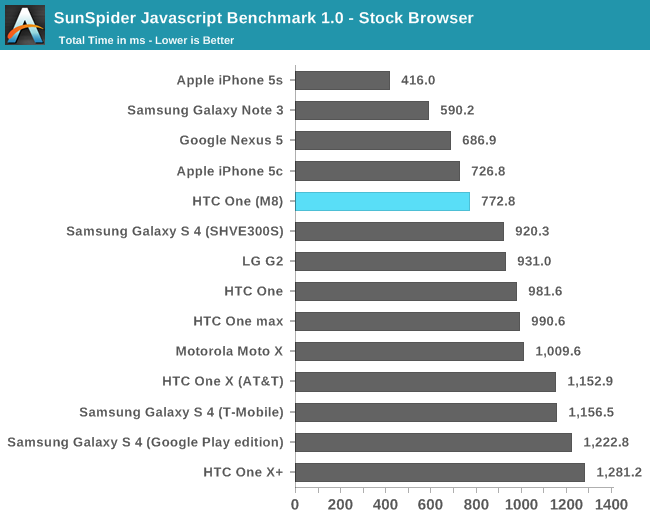
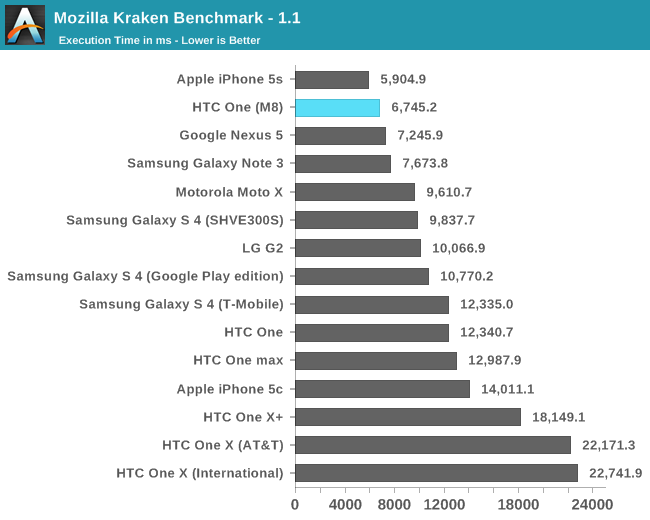
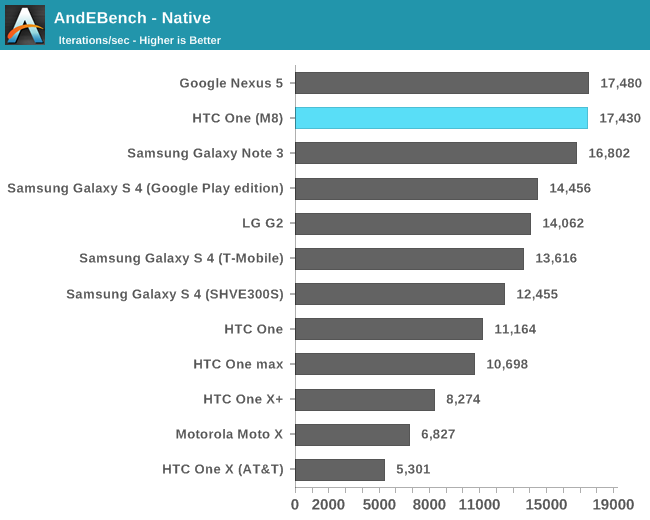
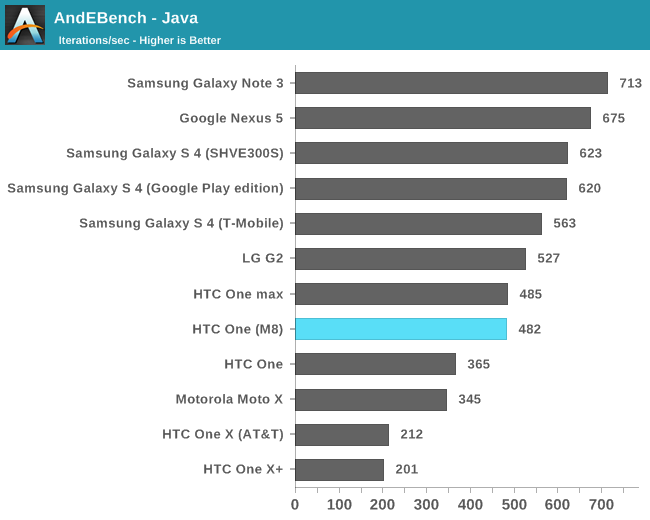
GPU Performance
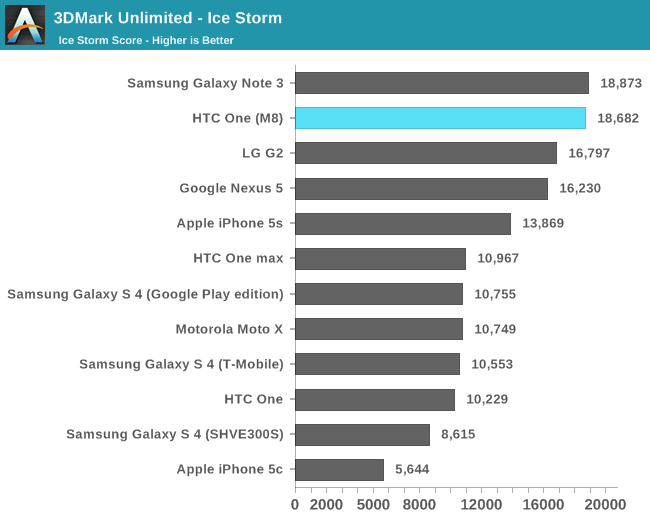
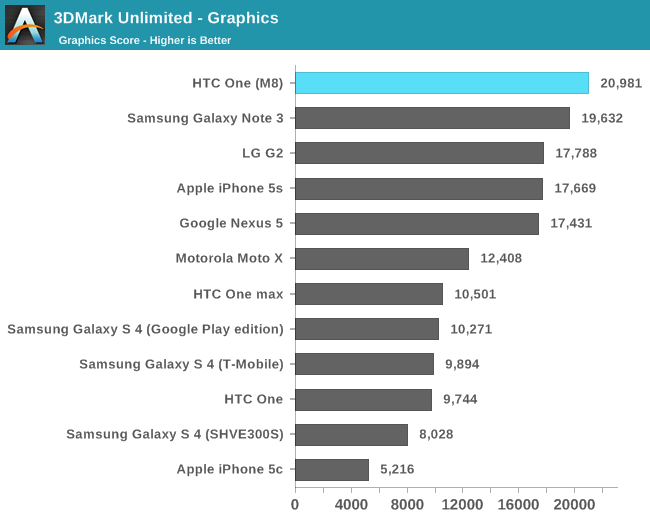
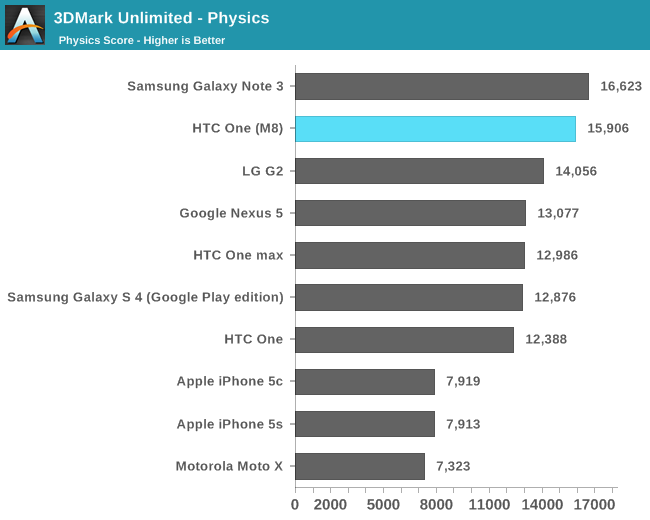
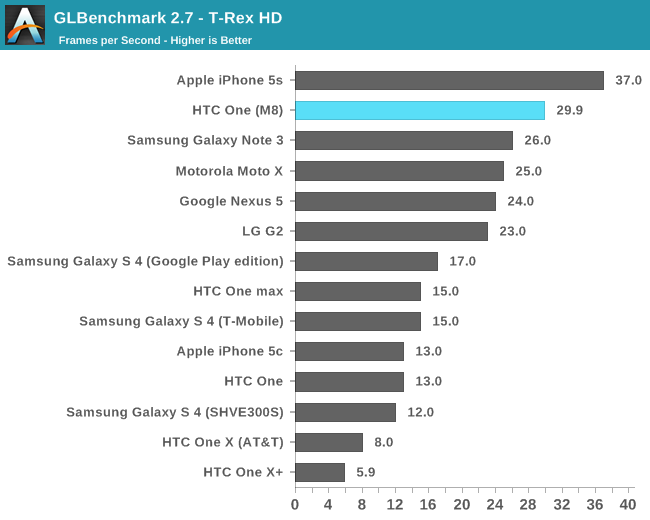
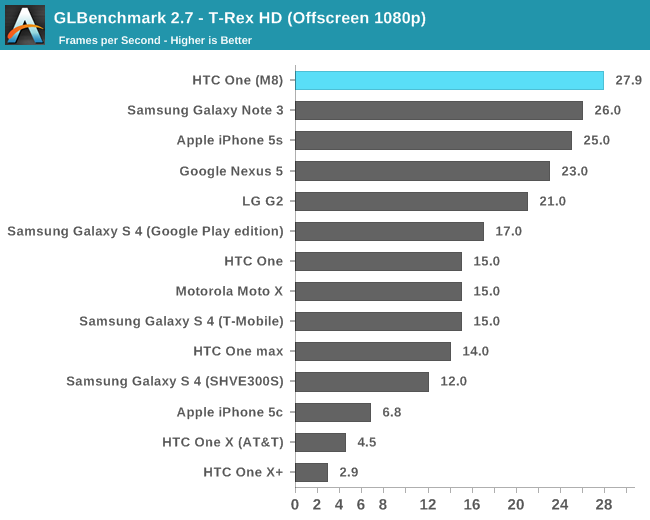
NAND Performance
The One is available in either 16GB or 32GB configurations, there are no higher capacity versions offered. There is now a micro SD card slot on the right side of the device, just above the volume rocker.
Despite using a Snapdragon 801 SoC, the internal storage is still an eMMC 4.5 solution.
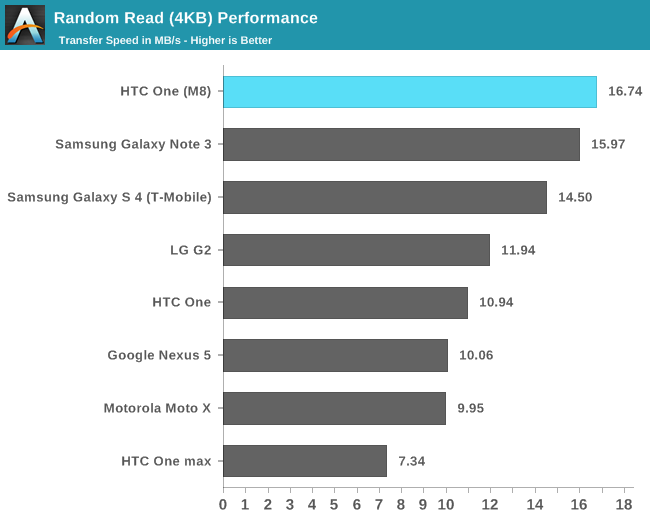
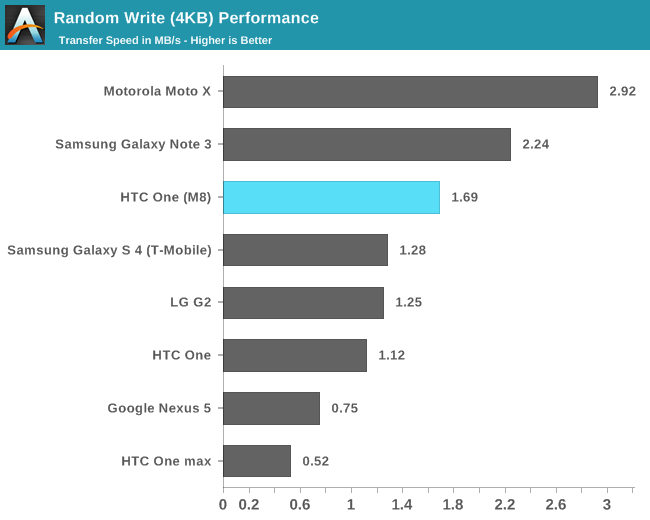

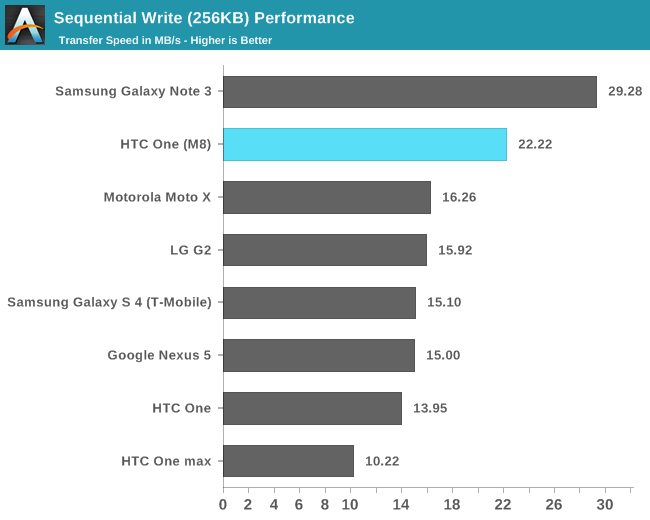


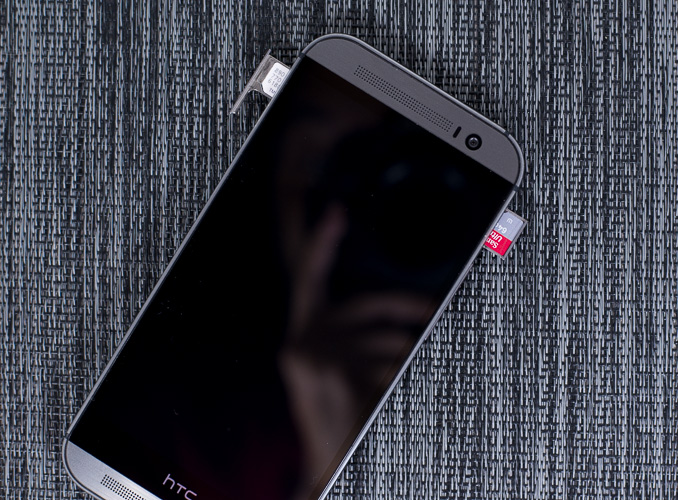








222 Comments
View All Comments
piroroadkill - Thursday, March 27, 2014 - link
Agreed. Z2 is the real Android flagship.Blairh - Thursday, March 27, 2014 - link
Very odd that not a single word was written about BoomSound.M8 is a big let down IMO. I would recommend it, but personally I find it too tall and heavy this round. A hypothetical 5" screen on the same footprint as the M7 would have been superior. Poor camera, ugly bezel, too tall. I hope HTC comes back stronger next year.
flashbacck - Thursday, March 27, 2014 - link
I've been say'n, if they're going to cheat on performance benchmarks, you should use those same benchmarks to measure battery life!flashbacck - Thursday, March 27, 2014 - link
Hmm. The low light seems ok, but it's not dramatically better than anything else.bhupatib - Thursday, March 27, 2014 - link
Disappointed that Anand didn't do any audio quality test. GSMArena's analysis suggests impeccable audio output but I really doubt their testing methodology. But I'm happy HTC gave us bottom headphone jacks! Don't troll me on that, but I just think USB and headphone jack belong at the bottom. I know G2 does that too but going by AT's audio benchmark, it has less than stellar audio quality.Someone posted about the next One mini being the more reasonable buy and I agree (unless the next Moto X beats it to it). We won't get SD801, but if it looks just as good with the same port placement, audio quality and battery life, great ! Paying extra for that gimmicky dual camera to get the kind of effects I was doing when I first learnt Photoshop - bad, amateurish, no thank you! I'm not averse to camera features on a phone, I just think HTC missed an opportunity to implement something awesome instead of creating another fancy name (UltraPixel).
My take? A single, large sensor (at least 1/2.3", ideally 1") camera optimized primarily for shooting 4K videos. Why? A frame grab from a 4K video with well implemented codec has just as much detail as any good 8MP still shot - so 4K gets you the eyeballs and without any further effort you get decent stills quality. SD801 is capable enough, HTC just needed to add improved optical stabilization and at least 50mbps H.264 profile. That, along with 1080p60 and 720p120, would have been much more logical.
Pretty certain iPhone 6 will have some advanced OIS and the fusion of videography and photography is the way to go in the 4K era.
Anand Lal Shimpi - Thursday, March 27, 2014 - link
Audio quality testing happens out of a physically different location, we're working on it next though :)Laxaa - Thursday, March 27, 2014 - link
Does it still have the "HDR Mics" as the M7 had? The one's that doesn't distort loud noises?Biln3 - Thursday, March 27, 2014 - link
i know the screen in the new one is .3" bigger but aren't they effectively the same size since the new one has screen shrinking onscreen buttons?hughlle - Thursday, March 27, 2014 - link
Rather what i was thinking. They removed the old buttons, but maintained the black bar. It all seems rather counter productive.TrackSmart - Thursday, March 27, 2014 - link
BINGO! This *really* annoys me the One M8! The new display makes the phone larger, but doesn't provide extra screen real estate. It's a lose-lose situation.Sure, the on-screen buttons are more versatile and can be updated with the software, but lost screen real estate is a painful compromise. Especially, when you the phone doesn't get any smaller for the loss of capacitive buttons. The Moto X is probably the only flagship device that actually used on-screen buttons as a way to reduce phone size. Almost every other implementation was a lost opportunity.